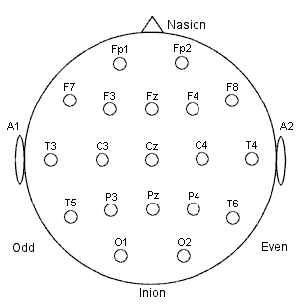Something I should've put in the first post was the 10-20 International System of electrode placement map (what most EEG based neurofeedback practitioners use):

Now that I started this thread to get things going, I'm going to pick a topic category (if anyone wants to post something in regards to neurofeedback under a different topic than what I have below feel free to do so just please write a topic category above it so that people can track what's going on):
Non-traditional Nuerofeedback:
Topic HEG:
There are 2 types of HEG (hemencephalagrpahy or neurofeedback that focuses on changing bloodflow as opposed to EEG patterns done with traditional neurofeedback). Buying one of these would cost about the same as a brand spanking new labtop cpu but I think it would be a great maximizer.
There's one paper found I found that compares HEG to EEG (
http://www.biocompre...rg/EEGorHEG.pdf). It appears both pir or nir HEG can serve as a sort of primer before or in combination with traditional EEG based neurofeedback training. I also found a Michigan based practitioner's website (the one's that charge you like a $100 each time you would go in for a session besides paying for it yourself) lists HEG as maybe yielding a faster response rate than EEG
http://www.flexiblebrain.com/heg.htm. The only limitation for HEG training seems to be that unless you have a shaved head, training is usually limited to the forehead placements (or "frontal pole placements" as a nuerofeedback specialist would say).
There's 2 types of HEG:pirHEG:
HEG pIR (passive Infrared HEG). Jeffrey Carmen's system, measures infrared temperature off the forehead. The headband holds a small sensing box against the forehead.
http://www.brain-tra.......&item_id=39nirHEG (invented by Hershill Toomin whose site can be found at
www.biocompresearch.com):
HEG nIR (near Infrared spectroscopy HEG). Hershel Toomin's system, measures oxygenation of cerebral blood flow. The headband contains an optical sender and sensor.
http://www.brain-tra.......&item_id=39About HEG (Hemoencephelography)
<H3 class=h3>How the Headbands Work</H3>An area of the brain that is more active will give off more heat and have greater blood flow and blood oxygenation than a brain area that is less active. The two HEG headbands take advantage of these facts.
The pIR or passive infrared headband, developed by Jeffey Carmen, measures the infrared temperature at the skull under the headband sensor, an infrared thermometer. It is passive in the same sense that EEG electrodes are. It measures but introduces no signals of its own to the brain. After experimenting with several forehead placements, Carmen now believes pIR HEG training is most effectively done at FPz. You run about 5 minutes of baseline until the temperature stabilizes, then set a threshold and start training.
The nIR or near infrared headband, developed by Hershel Toomin, utilizes the fact that more highly oxygenated blood is redder in color. It sends pulses of red and infrared light through the skull to the cortex beneath. (The skull itself is not opaque but translucent.) By measuring the amount of red compared to infrared light that is reflected back by the cortex to the headband sensor, the headband can indicate how much oxygen there is in the blood. Because the light pulses take battery energy, the nIR headband uses more energy and has a lower battery life than the pIR headband.
The nIR headband can be placed at most locations on the skull. However, at hair covered areas, the hair needs to be parted and this can be a difficult skill to learn. The headband is typically used to train frontal areas.
See detailed instructions on using nIR HEG.
<H3 class=h3>Using HEG</H3>While HEG is not as flexible as EEG, it's advantages are that the sensors are very easy to apply without mess and that artifacts are minimal. Atifacts in EEG data are particularly problematic in frontal areas.
Both HEG systems have been used successfully with conditions that benefit from learning to increase activation of prefrontal areas, which are normally the most active areas of the brain. pIR has been particularly successful with migraines (see sidebar), and nIR was first used with attention issues, but both methods are now used in a wide range of situations. You would not, however, use either method where beta and hibeta levels were high.
That being said, there is not yet definitive information on how large an area of the brain is influenced by nIR or pIR HEG training. Nor are there clear indications for choosing between nIR and pIR.
<H3 class=h3>Examples</H3>Here are a couple of examples of what HEG training can be like, including the Toomin Attention Index:
"... pIR HEG training... involves a type of conscious activity that produces the results.....this conscious activity is maintaining a very active engagement in focusing while staying relaxed and emotionally calm. Unlike a typical relaxation technique, this exercise teaches how to stay calm during active engagement. I've had several reports from clients who say that they can consciously transfer this strategy to every day life. But, after several sessions of training, the transfer is usually more automatic than deliberate."
Fred Bramble
"I have observed that the [nIR] HEG signal drops proportionally with the slightest decrease in attention. In this vein I have designed a BioExplorer function that rewards more constant attention.
To see more info. and pictures of this navigate around here:
http://www.brain-tra...eg_details.htmlLet me know what you guys think... Doesn't that moustrap game (link above) look kind of interesting?
Edited by yowza, 08 October 2009 - 05:09 AM.














































